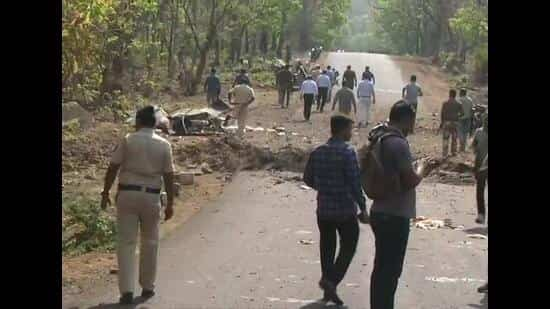Maoists were involved in maximum 39% of the attacks in 2021 followed by Pakistan-backed Lashkar-e-Taiba (50 or 9%)
Maoists were involved in the maximum number of terror attacks (225) in India in 2021 even as they overall dipped by 16% to 572 in 2021 compared to the previous year and were the lowest since 2018, according to a US state department analysis.
 Maoists were involved in the maximum number of terror attacks (225) in India in 2021. (ANI) At least 536 people were killed in such assaults in India in 2021 and accounted for 2% of global total fatalities in terror attacks (23,692). Maoists were involved in maximum 39% of the attacks in 2021 followed by Pakistan-backed Lashkar-e-Taiba (50 or 9%).
Maoists were involved in the maximum number of terror attacks (225) in India in 2021. (ANI) At least 536 people were killed in such assaults in India in 2021 and accounted for 2% of global total fatalities in terror attacks (23,692). Maoists were involved in maximum 39% of the attacks in 2021 followed by Pakistan-backed Lashkar-e-Taiba (50 or 9%).
The Resistance Front (TRF) was involved in 18 or 3% of the attacks and Hizbul Mujahideen 12. The analysis said 33% of attacks across India were not attributed to any group in 2021.
The analysis is part of the “Country Report on Terrorism 2021” (CRT) which the state department released on Monday.
It said India was in the top 10 countries for most terrorism incidents, but not in the top 10 for fatalities in 2021. “There was a 16 percent decrease in terrorism-related incidents from 2020 and a 5 percent decrease in fatalities from 2020.”
In 2020, 679 terror attacks were reported compared to 655 in 2019 and 673 in 2018.
The maximum 252 or 44% of the attacks were reported from Jammu & Kashmir in 2021 followed by Maoist insurgency-hit Chhattisgarh (119 or 21%) and Jharkhand (59).
In April 2021, 22 security personnel were killed and 35 others injured in a Maoist attack in Chhattisgarh’s Bijapur.
The then Prime Minister Manmohan Singh in 2010 called Maoist insurgency India’s biggest internal security threat.
CRT highlighted a shift in tactics and said terrorists were now targeting civilians with greater reliance on Improvised Explosive Devices (IEDs). It cited the drone-based IED attack in June 2021 on the Indian Air Force base in Jammu.
A National Investigation Agency probe concluded TRF was involved in the attack.
Shootings were the other common tactic used in 49% of the incidents followed by landmines (21%) and bombings (13%) in 2021.
The analysis noted the Indian government made significant efforts to detect, disrupt, and degrade the operations of terrorist organisations.
It added India and the US have committed to collaborating on improving border security and information-sharing capabilities.
The analysis said the US government is still waiting for a decision from the Indian government “on an offer to collaborate on watchlisting assistance.”
CRT said Indian law enforcement, including border security forces, face budgetary, staffing, and equipment constraints while pointing out issues India’s internal security apparatus faces.
“Capacity to patrol and secure extensive maritime and land borders is improving but not adequate, given India’s extensive coastline.”
The analysis said India does not have a counter-violent extremism (CVE) policy or a national coordinator. It added state governments have the lead on CVE and deradicalisation strategies. The analysis noted only five states have so far formulated a CVE strategy.
The analysis noted the Union home affairs ministry was in the process of preparing an action plan on strategic messaging to counter radicalisation. “Several federal agencies and state police forces monitor online platforms for extremist content and messaging.”
It cited India’s decision against bringing four citizen spouses of Indian ISIS fighters from Afghanistan after the Taliban takeover in 2021 and added India does not have the policy to repatriate foreign terrorist fighters or their families.
Internal security expert Sameer Patil said the report broadly vindicates the trend that terrorist threat to India is getting diffused as terrorist organisations along with front groups such as TRF shift to targeted killings of civilians and other soft targets by utilising hybrid terrorists and lone wolves.
“In Kashmir Valley, this threat obviously gets amplified due to the Pakistani establishment’s support to the insurgency. The report also showcases the success of the Indian security agencies in neutralising terrorist threats to the Indian hinterland despite challenges as outlined.”











